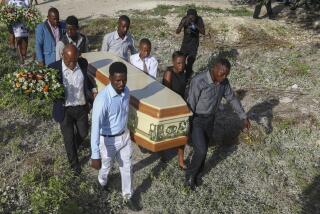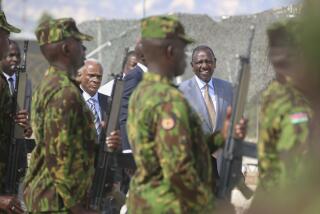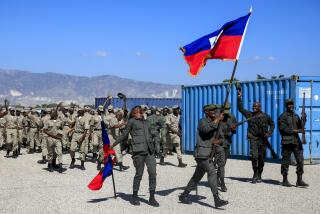CRISIS IN THE CARIBBEAN : Blast Shows All the ‘Face of Evil’ : Violence: Attack on civilians brings the harshest U.S. condemnation of Haiti’s lingering military rulers.
PORT-AU-PRINCE, Haiti — James Benjamin clutched his shrapnel wounds Thursday as he lay bleeding on top of his protest poster with the red-and-blue paint declaring, “First Justice, Then Reconciliation.”
Wincing as he waited for the ambulance in the blistering afternoon sun, the young pro-democracy demonstrator summed up the most brutal attack by Haiti’s paramilitary forces since the U.S. military landed here to put an end to just such horror.
“Now you know what life is like for the people in Haiti for the past three years,” Benjamin said in a near-whisper, moments after members of a paramilitary squad apparently threw at least one grenade into his group of hundreds of demonstrators Thursday afternoon, killing or wounding at least 40.
“It isn’t a life. It is this. It’s living death,” Benjamin said.
It happened at 1:45 p.m., as the group was marching home after welcoming the U.S.-backed return of Port-au-Prince’s charismatic, democratically elected mayor, Evans Paul. They were passing a small cement warehouse owned by Haiti’s dreaded police chief, Lt. Col. Michel-Joseph Francois, when, Benjamin said, he stopped to buy some water. He spotted two paramilitary agents nearby, but it was too late.
Within seconds, he said, the explosion deafened him. The shrapnel ripped through his leg and abdomen.
The attack brought the harshest U.S. condemnation of Haiti’s lingering military rulers since the first American troops arrived 10 days earlier. Briefing reporters on the incident, U.S. Embassy spokesman Stanley Schrager poignantly echoed Benjamin’s words.
“It’s important that the world can now see the face of evil that has been operating in this country for many years,” Schrager said, moments before U.S. Ambassador William L. Swing condemned the attack and appealed to the Haitian nation for calm.
For U.S. military commanders in Haiti, the second bloody assault on pro-democracy demonstrators in two days foreshadowed what many observers fear is worse violence to come.
It occurred on the eve of the third anniversary of the coup that overthrew President Jean-Bertrand Aristide and brought Francois and Haiti’s other military rulers to power.
Today, amid plans for a huge religious service and a massive pro-Aristide march in the capital, senior U.S. commanders are expecting the worst. They have an intricate plan to keep the violence to a minimum. But in a city awash with rumors that the attacks are part of a calculated Haitian paramilitary plan, Schrager conceded: “We can’t be everywhere at once.”
In fact, he stressed that it is not the U.S. military but the Haitian police and army that are in charge of law and order here. The intervention force, he said, plans to function only as a deterrent.
On Thursday, though, the U.S. forces were not far away.
A U.S. Army military police company was just 10 minutes away when at least one grenade exploded amid the marchers. With assault rifles ready and a dog team in tow, the soldiers jumped out of their Humvees and opened fire on the warehouse, causing no apparent injuries and drawing no return fire. The dog team tracked the attackers, at least one of whom was led away in handcuffs minutes later.
The MPs looked a lot like policemen, a role that U.S. forces commander Lt. Gen. Hugh Shelton has insisted the U.S. military is not--and should not be--playing in Haiti. But that was the role the crowds demanded the MPs assume as people quickly gathered at the scene.
“We are not here as policemen. We are here to assist the Haitian police,” a U.S. Army translator shouted in Creole through a loudspeaker in one of the Humvees.
As ambulances snaked their way through to take away the dead and wounded, the crowd began a chant: “Down with the police! You be the police! Down with Francois! Long live Aristide!”
Another siren wailed as a black van filled with uniformed Haitian police tried to push through the crowd to the blast scene. The crowd attacked the van, smashing out the back window before the vehicle managed to get through.
Word spread fast from eyewitnesses like James Benjamin: The man who threw the grenade and was taken away by the Americans, they said, was known to be a lieutenant who worked directly for Francois.
The final moment of fury at the scene illustrated what many fear lies ahead in Haiti: anarchy.
When the U.S. troops finally pulled away from the warehouse nearly two hours after the attack, the crowd descended on it in a frenzy. Grinning and shouting chants of victory and justice, as they have several times elsewhere in the city in recent days, the marchers carted off every last bag of Francois’ cement.
U.S. Troop Tally
Though Pentagon officials initially anticipated only 15,000 troops would be involved in the Haiti operation, there are now nearly 20,000 on the ground there. And the number “may go a little higher,” a Pentagon spokesman said Thursday.
U.S. military troops on the ground: 19,600
Troops and sailors offshore: 9,200
Total overall U.S. deployment: 28.800
PEAK DEPLOYMENT
Persian Gulf: 541,000
Somalia: 25,800
U.S. invasion of Panama: 25,750
Sources: U.S. Army’s Center for Military History, Associated Press
More to Read
Sign up for Essential California
The most important California stories and recommendations in your inbox every morning.
You may occasionally receive promotional content from the Los Angeles Times.










